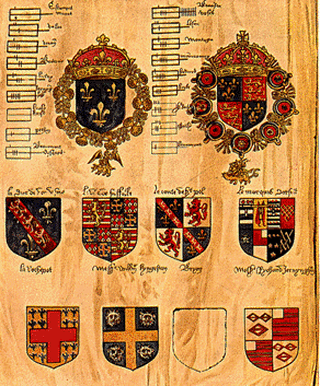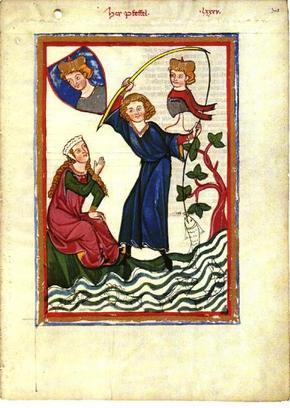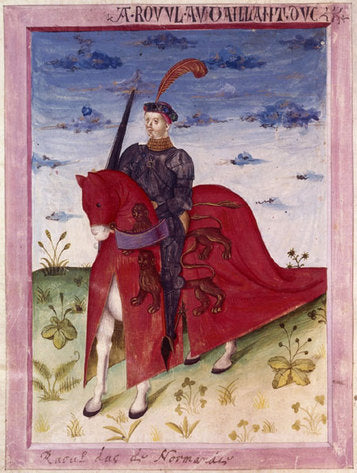
Early heraldic literature
 The earliest compositions on the subject of coats of arms are 200 years later than the first appearance of heraldic devices and 100 years after the early Rolls of Arms. John of Guildford, in the late 14th century asks the question “ Who can grant arms ? “ which he answers “ I say it is a king, a Prince, a King of Arms, or a Herald”. Another early writer on the subject was Nicholas Upton who wrote De Studio Militari. This composition and that of John of Guildford were printed in 1654 by Sir Edward Bysshe, Garter King of Arms, together with the Aspilogia of Sir Henry Spelmann written at the end of the 16th century. The whole document was in Latin and no version of Nicholas Upton’s work has been published in English, although John Blount, an Oxford student, made a manuscript translation in about 1500. Nicholas Upton was a Canon of Salisbury Cathedral, and his book is dedicated to Humphrey, Duke of Gloucester, who died in 1447, and the book may therefore be dated about 50 years later than that of John of Guildford. There is a chapter on the assumption of arms which is important, and from which the following quotation is taken.
The earliest compositions on the subject of coats of arms are 200 years later than the first appearance of heraldic devices and 100 years after the early Rolls of Arms. John of Guildford, in the late 14th century asks the question “ Who can grant arms ? “ which he answers “ I say it is a king, a Prince, a King of Arms, or a Herald”. Another early writer on the subject was Nicholas Upton who wrote De Studio Militari. This composition and that of John of Guildford were printed in 1654 by Sir Edward Bysshe, Garter King of Arms, together with the Aspilogia of Sir Henry Spelmann written at the end of the 16th century. The whole document was in Latin and no version of Nicholas Upton’s work has been published in English, although John Blount, an Oxford student, made a manuscript translation in about 1500. Nicholas Upton was a Canon of Salisbury Cathedral, and his book is dedicated to Humphrey, Duke of Gloucester, who died in 1447, and the book may therefore be dated about 50 years later than that of John of Guildford. There is a chapter on the assumption of arms which is important, and from which the following quotation is taken.“ We come now to the question lately raised, whether arms bestowed by the favour of princes or of some other lord are better or of such dignity as arms taken by a man’s own authority. It has been said above that it has been committed to each noble to take arms and ensigns to himself as he pleased. I have said something on this question in my book on the feudal lord. In understanding this question it must be noted that there are four ways in which we may have arms. (i) We have arms which we bear from our ancestors, a manner well known and frequent. (ii) We have arms by our own merits. (iii) We have arms which we bear from the favour of a prince or other lords, and note here, that arms which we receive from grant of a prince, are not queried since a prince does not desire this, unless someone shall have borne these arms before. ( iv) We have arms which we bear taken by our own authority as we see openly in these days as many poor men who have toiled in the French war have been ennobled, some by prudence, some by force of character, some by courage, some by other qualities. These men as I have said above, are ennobled, many of whom assume arms of their own authority, to be borne by themselves and their heirs. The names of these there is no need to recount here. I will confess, however, that though arms thus assumed are freely and lawfully borne, they have not as much dignity and authority as those which are granted by the authority of princes and lords. But arms assumed by one’s own authority are valid enough, provided they have not been borne by anyone else before. Nor would I dare to approve the opinion of those who say that heralds can grant arms, but I say if arms are borne which are granted by a herald those arms are of no greater authority than arms taken by a man’s own authority.”
 One of the most interesting cases of early Heraldic literature comes from a woman, Dame Juliana Berners who wrote the Boke of St. Albans. Very little is known about Dame Juliana beyond her authorship of this book. She was supposedly a Prioress of Sopwell, a convent near St. Albans in Hertfordshire in the south of England. The book was first printed in the Abbey of St. Albans which gives it it’s name. The book is divided into 5 sections and contains a Treatise of Hawking, of Hunting, of Coat Armour, of Fishing, and Blazing of Arms. The third and fifth portions of the work concern Heraldry, but the whole composition represents a dissertation on some of te main accomplishments of a 15th century gentleman in England.
One of the most interesting cases of early Heraldic literature comes from a woman, Dame Juliana Berners who wrote the Boke of St. Albans. Very little is known about Dame Juliana beyond her authorship of this book. She was supposedly a Prioress of Sopwell, a convent near St. Albans in Hertfordshire in the south of England. The book was first printed in the Abbey of St. Albans which gives it it’s name. The book is divided into 5 sections and contains a Treatise of Hawking, of Hunting, of Coat Armour, of Fishing, and Blazing of Arms. The third and fifth portions of the work concern Heraldry, but the whole composition represents a dissertation on some of te main accomplishments of a 15th century gentleman in England.
Dame Juliana is acknowledged to have used Upton’s earlier work in completing her Treatise. In her fifth section she incorporates a great deal of his work on Heraldry. Nevertheless, she does shed new light on the origins of Heraldry: “ Note here well who shall give coat armours. There shall none of the nine orders of regality but all only the sovereign king give coat armours. For this is to him impropriated by law of arms. And yet the king shall not make a knight without coat armour before.”This would seem to favor the viewpoint thatnone but “ properly granted “ coats of arms were genuine. However, with the iconsistencies which mark so many ancient writers Dame Juliana follows her assertion with a contrary one: “ Every knight, chieftain,in the field may make a coat armour knight.” Other chapters describe the case of a man whose father had not coat of arms but his mother had, and he may bear his mother’s arms. Elsewhere she says : “ Some men say that a Christian manovercoming a Christian man fighting in the listshall bear the coat armour of him that is overcome.” And “ a yeoman christened may bear the arms of a gentleman Saracen ( i.e. a pagan) if he kill him.”. (photo: Dame Juliana Berners)
Early Heraldic literature was not confined to England. John of Guildford referred to Bartholus as a great authority on the subject of Heraldry. This Bartholus or Bartolo of Sassoferrato was a well know medieval Italian jurist who died in 1356. He has been referred to as the father of international law. He lived from 1314 to 1356 and was at different times professor of law at Bologna, Pisa and Perugia universities. His book Tractatus de Insigniis et Armis, is the earliest known composition on Heraldry.
The English writers of these early times follow him closely, quoting him as decisive on disputed points of law. His treatise can be seen in the British Museum in a copy dated to 1475 in black letter Latin. In the relevant portion of the book Bartholus says, after dealing with the arms proper to princes: “ There are certain insignia or arms of private men or nobles or of peoples, among these are some who bear arms and insigniawhich have been granted to them by the Emperor or some other lord, as I have seen granted to many by the most serene prince Charles the 4th, Holy Roman Emperor and King of Bohemia. To me also, his councilor, he granted arms among the rest, so that I and others of my family should bear a red lion,, double tailed, on a field of gold ( Or a lion gules double queued). That such persons are able to bear arms there can be no doubt, for it is sacrilege to dispute the power of a prince. In addition, some take arms to themselves of their own authority and it should be considered whether this is lawful. And I think this is lawful, just as names were invented to distinguish men. In this way insignia were invented for the same purpose, and just as one is allowed to take names at pleasure, so too one may take arms and place them on his own shield but not on anothers. “
Bartholus gives careful consideration to the position of persons who, not being of the same blood, yet have the same arms. “ For instance a German went to Rome in the time of indulgence where he found a certain Italian who bore the arms of his ancestors. He wished to complain of this. But indeed he could not, for so great is the distance between both places , that the former man could not be injured by this. “ Bartholus agrees that a skillful smith who puts a mark on his sword and whose workmanship makes his weapons sought after, should be able to protect his own trademark; so too should notaries and mapmakers.” What then”, he asks “ is the value of a grant of arms from a prince? First, that is of greater dignity. Second, that no one can prohibit one from wearing them. Third, because if two persons assume the same arms, and there appears no difference in priority, he is preferred who had his arms from the prince. Fourth, if one is in the army or in any other place, and questions arise as to precedence, those arms should be preferred which are granted by a prince.”
 These early writers of Heraldic literature, wrote in days when Heraldry was in everyday use and they constantly saw living illustration of coats of arms. Armoury or Heraldry was established to meet a practical need and was not under centralized control until a late period. Heralds did not come into existence until after Heraldry came into existence, just as registrars of births did not exist prior to births themselves. At first Heralds were unofficial personages attached to the Nobleman or King’s court just like any other domestic help. The functions of the Heralds expanded because among other things it was very useful to have lists of arms and their users. The early Rolls of Arms were compiled, not by officials as we know have at the College of Arms in London or the Lord Lyon Office in Scotland, but by men who had an amateur interest in the subject and who might have had some semi-official appointment with a nobleman or king.
These early writers of Heraldic literature, wrote in days when Heraldry was in everyday use and they constantly saw living illustration of coats of arms. Armoury or Heraldry was established to meet a practical need and was not under centralized control until a late period. Heralds did not come into existence until after Heraldry came into existence, just as registrars of births did not exist prior to births themselves. At first Heralds were unofficial personages attached to the Nobleman or King’s court just like any other domestic help. The functions of the Heralds expanded because among other things it was very useful to have lists of arms and their users. The early Rolls of Arms were compiled, not by officials as we know have at the College of Arms in London or the Lord Lyon Office in Scotland, but by men who had an amateur interest in the subject and who might have had some semi-official appointment with a nobleman or king.
The Armorial de Berry, the earliest Roll of Arms in Scotland was created by a French royal herald, Gilles le Bouvier, who was appointed Berry King of Arms and premier herald of France. Despite his official position , or perhaps because of it as heralds were used as envoys and ambassadors, he traveled widely and recorded the arms of persons in France, England, Scotland, Germany, Italy and other countries. He went to the homes of Noblemen and Gentleman whose arms he wished to record and no doubt received their hospitality. This explains some gaps in his work. In some cases the lord of the castle was not as home, in other cases Gilles le Bouvier did not think it worthwhile to enter that part of the country because he might not get paid for his efforts. A herald very often would not enter a coat of arms into the roll if he felt he would not be paid for it. In his preface to the Armorial de Berry Roll, le Bouvier adds that he was guided neither by love nor hate in setting down arms, but put them exactly as they were given to him. In other words he exercised no official control but accepted the coats of arms on the guarantee of their bearers.(photo: Armorial De Berry)

Gilles Le Bouvier
Back to menu
Shop Our Products
CTA Text

-
-
Bring Your Idea to Life
Start with a personalized consultation, sharing your vision and preferences with our expert design team. With over 20 years experience we have the knowledge and craftsmanship to create a unique piece of jewelry that will be cherished for generations to come.









